For ideal herbal soap infusions, you'll want to maintain your oil temperature between 110-120°F, never exceeding 140°F to protect therapeutic properties. Using a slow cooker's warm setting with the lid off provides consistent heat while preventing moisture buildup. Check temperatures every 30 minutes and adjust as needed during the 4-6 hour infusion process. Mastering these precise temperature ranges will transform your herbal soap's potency and quality.
Understanding Temperature Ranges for Oil Infusion
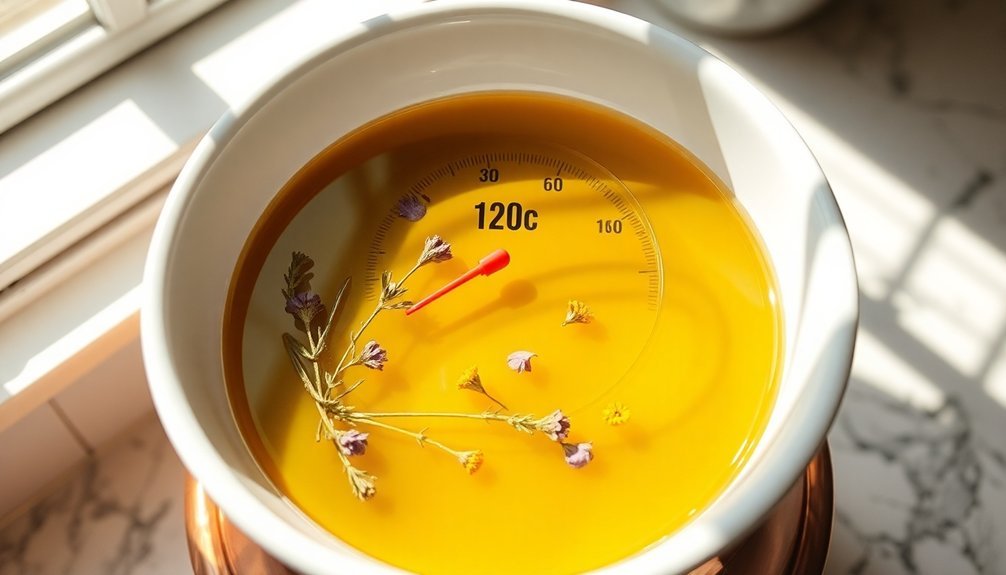
When creating herbal-infused oils for soap making, maintaining the right temperature is vital for extracting beneficial compounds while preserving the oil's integrity.
You'll want to keep your oil infusions between 110-120 degrees Fahrenheit to achieve the best results for your herbal soaps.
As you infuse oils, it's important to monitor the temperature carefully, as exceeding 140 degrees can damage both the herbs and the oil quality.
A slow cooker on the warm setting is your best friend here, providing consistent heat throughout the 4-6 hour infusion process.
You'll find this method particularly reliable for maintaining the ideal temperature range while extracting the maximum benefits from your herbs.
Selecting the Right Heat Method for Different Herbs
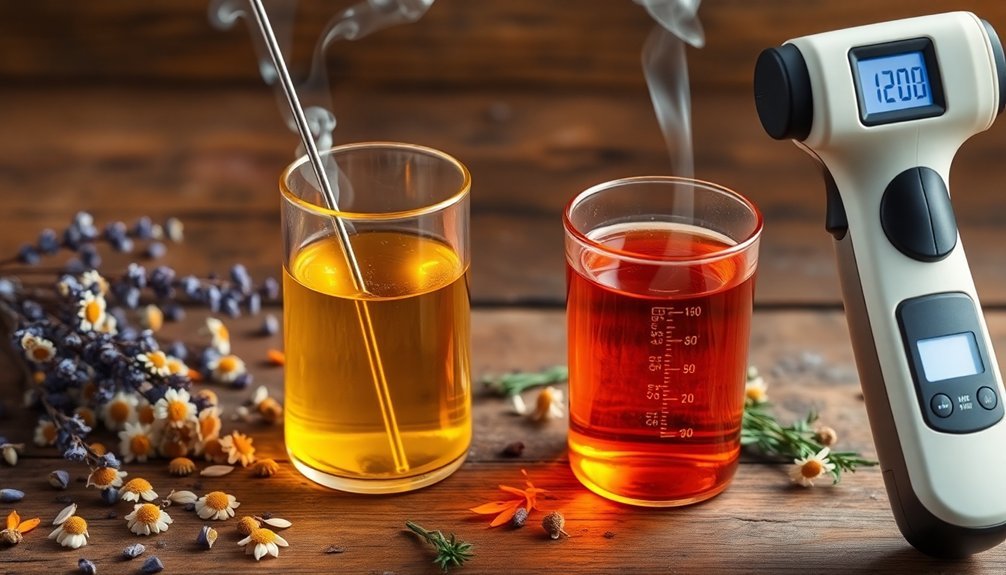
Different herbs demand distinct heat methods for ideal oil infusion in soap making. When you're infusing oils with tough roots, you'll need to use a hot infusion or decoction method, while delicate flowers require gentler treatment.
For the best results, maintain temperatures between 110-120°F using a slow cooker or double boiler.
Before you start infusing herbs in oil, consider their moisture content. You'll want to wilt fresh herbs first to prevent your oil from turning rancid. Dried herbs can go directly into your infusion.
Keep your infusion time to 4-5 hours, as extending beyond this period won't enhance the results and might degrade your oil. Remember not to exceed 140°F during the process, as this helps preserve the beneficial properties of your herbs while ensuring a quality soap-making base.
Temperature Control Techniques and Equipment
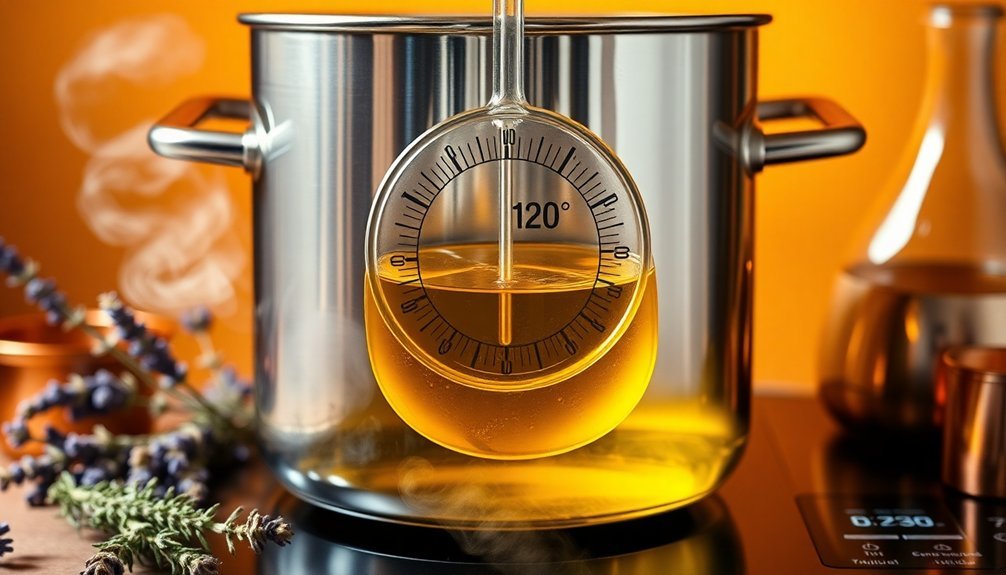
Precise temperature control makes all the difference in successful herbal oil infusions. When you're creating herbal soaps, maintaining temperatures between 100° and 140°F guarantees ideal extraction without damaging your dried herbs or oils.
Your slow cooker's warm setting provides an ideal temperature control technique for oil infusion. Keep the lid off to prevent moisture buildup and allow proper evaporation, which helps maintain your oil's clarity.
You'll want to monitor the temperature regularly with a thermometer to verify it doesn't exceed the recommended range. If you notice the temperature climbing too high, adjust your slow cooker accordingly.
Remember to check your infusion frequently throughout the process. This hands-on approach lets you make quick adjustments and prevents overheating, making sure you'll achieve the best results for your herbal soap making.
Common Temperature-Related Mistakes to Avoid
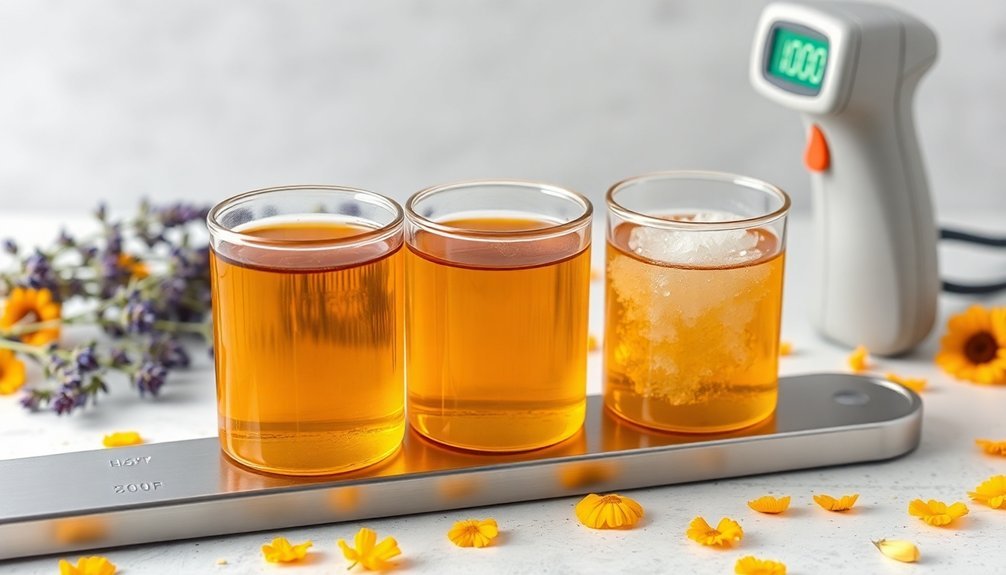
You'll want to watch out for overheating flower oils above 120°F, which can quickly destroy their therapeutic properties and create an unpleasant, burnt aroma.
Failing to monitor your infusion temperatures consistently throughout the process can lead to quality issues and wasted ingredients, especially when working with temperature-sensitive herbs.
Rushing the cooling phase by straining the oil while it's still warm compromises the final product's clarity and increases the risk of plant material contamination.
Overheating Delicate Flower Oils
When making herbal soaps with flower-infused oils, maintaining proper temperature control is crucial to preserve their delicate properties. You'll need to keep temperatures between 110-120°F to protect the volatile compounds that give your oils their therapeutic benefits and fragrance.
To properly infuse herbs, use a water bath method instead of direct heat. This technique helps you maintain steady temperatures and prevents the sudden heat spikes that can damage your oils.
Don't let your infusion process run longer than 1-3 hours, as extended heating will diminish the oils' effectiveness and may create an unpleasant burnt smell. Remember to strain your infused oils promptly after they're done – this removes plant materials that could continue heating the oil.
Regular temperature checks throughout the process will guarantee you're preserving all the beneficial properties of your flower oils.
Inconsistent Temperature Monitoring
Temperature monitoring stands as one of the most critical yet commonly overlooked aspects of oil infusion. When you're making oil with herbs, inconsistent temperature checks can seriously compromise your final product.
You'll need to maintain temperatures between 100°F and 140°F for ideal extraction of beneficial compounds.
Don't make the mistake of checking temperatures sporadically or relying on guesswork. Your infused oil requires steady monitoring, especially when using slow cookers or double boilers.
Keep a reliable thermometer handy and check readings frequently to prevent temperature fluctuations that can lead to uneven infusion.
Always let your oils cool completely before straining to guarantee clarity and prevent sediment from becoming trapped.
Rushed Cooling Process
Despite the enthusiasm to complete your herbal soap-making process, rushing the cooling phase of oil infusions can severely compromise your final product.
A rushed cooling process often leads to condensation inside your containers, creating an environment that promotes unwanted microbial growth.
When you cool your infused oils too quickly, you're risking thermal shock, which can cause uneven solidification and affect your soap's texture.
Instead of placing your oils directly in cold environments, let them cool naturally at room temperature.
If you need to speed up the process slightly, use a water bath to maintain controlled cooling.
You'll find that allowing your infusions to cool gradually helps preserve their beneficial properties and prevents separation of ingredients, ensuring your herbal soaps achieve the desired consistency and quality.
Best Practices for Heat-Infused Soap Making
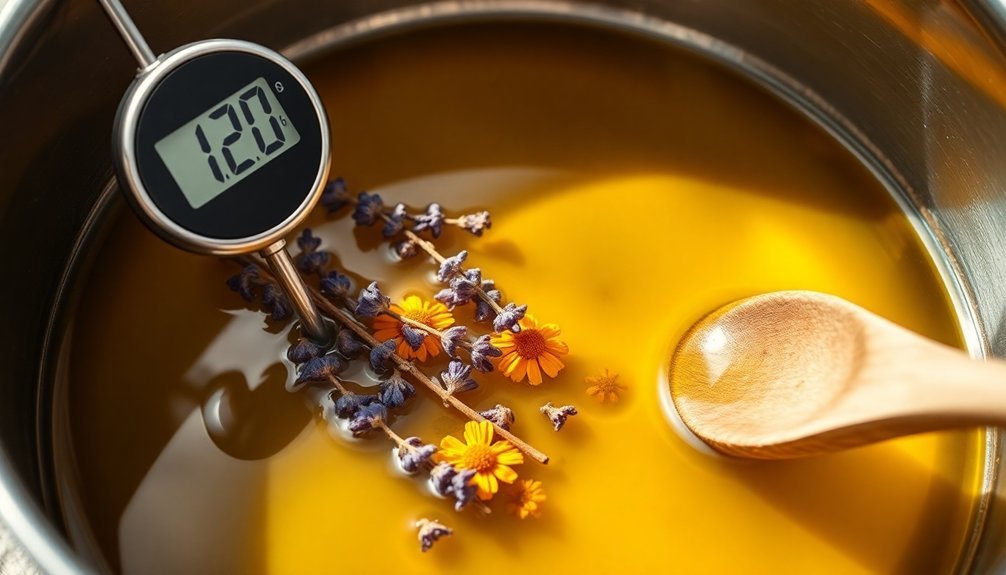
Although heat-infused soap making requires patience, mastering the proper temperature control will greatly enhance your final product. When you infuse olive oil with herbs for Natural Soap Making, maintain temperatures between 100°F and 140°F for ideal extraction.
| Time | Temperature | Action |
|---|---|---|
| Start | Room temp | Add herbs to oil |
| Hour 1 | 100°F | Begin slow heating |
| Hours 2-4 | 120°F-140°F | Maintain steady heat |
| Hour 5 | 130°F | Check infusion |
| Hour 6 | 120°F | Strain while warm |
For Cold Process soap making, you'll want to use your slow cooker's warm setting for 4-6 hours. Don't rush the process – a longer infusion of up to 24 hours can create richer results. Once complete, strain your oils while warm and store them in sterilized glass containers away from light for up to six months.
Testing and Monitoring Oil Temperature Stability
You'll need to perform regular temperature range safety checks between 100°F and 140°F using a digital thermometer to make certain your herbal oil infusion maintains ideal extraction conditions.
Your digital thermometer should be calibrated and cleaned between readings, with temperature measurements taken at different points in the oil to verify even heat distribution.
Testing the stability of your heat source by monitoring temperature fluctuations over time will help you adjust your setup to prevent overheating and maintain consistent infusion quality.
Temperature Range Safety Checks
When making herbal-infused soaps, monitoring oil temperatures carefully is crucial for achieving best results.
You'll need to maintain temperatures between 110°F and 120°F for ideal herbal extraction while protecting the oil's integrity.
To guarantee proper temperature control during your infusion process:
- Keep a thermometer handy and check readings frequently – never let temperatures exceed 140°F.
- Use a slow cooker or water bath method to maintain consistent heat throughout the 4-6 hour infusion period.
- Monitor your setup regularly to prevent temperature spikes that could damage both oil and herbal properties.
Digital Thermometer Best Practices
Building on proper temperature control, selecting and using the right digital thermometer makes all the difference in successful herbal oil infusions.
You'll need a device with a temperature range from 32°F to 400°F to accurately monitor oil infusion temperatures between 110°F and 140°F.
To get precise readings, position the probe in the oil without letting it touch the pot's bottom. Check your oil temperature every 30 minutes to maintain consistent heat levels and prevent burning your herbs.
If your digital thermometer includes a built-in timer, you can easily track both temperature stability and infusion duration simultaneously.
Don't forget to calibrate your digital thermometer regularly, especially after it's been exposed to extreme temperatures. This guarantees you'll get reliable readings throughout your herbal soap-making process.
Heat Distribution Testing Methods
To maintain ideal infusion quality, proper heat distribution testing is vital throughout the oil infusion process.
You'll need to monitor the oil temperature consistently to guarantee optimal herb extraction. Using an immersion thermometer, check that your mixture stays between 110-120°F while stirring periodically to prevent hotspots.
For reliable temperature monitoring, you can:
- Set up a water bath on your stovetop with a thermometer, keeping temperatures under 140°F
- Use a slow cooker on warm setting to maintain stable heat distribution
- Insert a digital probe thermometer that stays in the oil throughout the infusion process
Regular testing helps you avoid overheating the herbs while guaranteeing even heat distribution.
Whether you're using a water bath or slow cooker method, consistent temperature checks are essential for successful herbal soap infusions.
Frequently Asked Questions
What Temperature Do You Infuse Herbal Oil?
You'll want to infuse your herbal oils between 100°F to 140°F (37°C to 60°C). For best results, maintain a water bath around 110°F to 120°F (43°C to 49°C), and don't forget to monitor frequently.
How to Infuse Oil With Herbs for Soap?
Wilt your herbs for 12 hours, then cover them completely with oil. Use a slow cooker on warm (110-120°F) for 4-24 hours. Strain while warm through cheesecloth, and store in a dark place.
What Temperature Should Herb Oil Be?
You'll want to keep your herb oil between 100°F and 140°F, with 110°F to 120°F being ideal. For quick infusions, maintain 120°F for 2-5 hours to extract the best properties from your herbs.
How Do You Infuse Oil With Medicinal Herbs?
You'll need to dry and chop your herbs, then combine them with oil in a slow cooker. Heat at 110-120°F for 4-24 hours, strain through cheesecloth, and store in a dark place.
In Summary
By following proper temperature guidelines, you'll achieve ideal herbal oil infusions for your soap making. Remember to keep oils between 95-120°F for delicate herbs and 120-140°F for hardier varieties. Don't rush the process – maintain consistent heat using reliable equipment and regular monitoring. When you master temperature control, you'll create potent, high-quality infusions that enhance your handcrafted soaps every time.

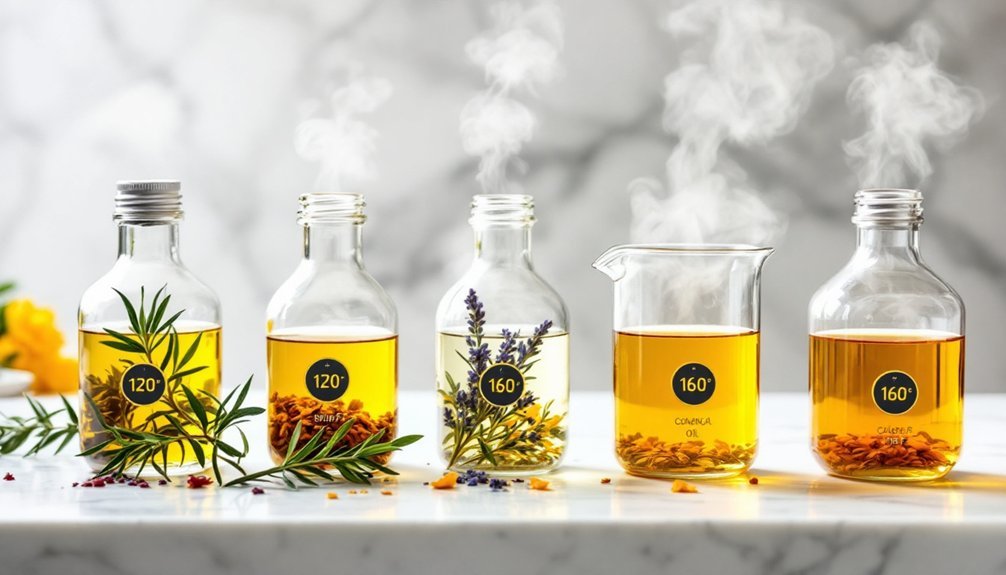



Leave a Reply